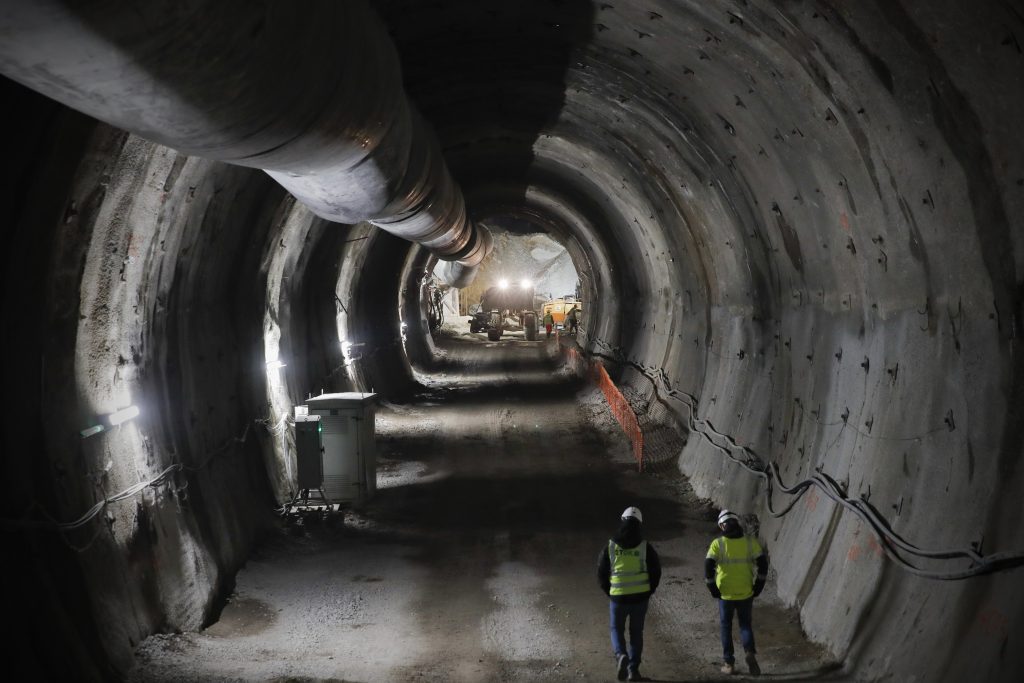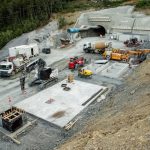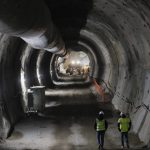 8 km of the total 20.5 km Divača-Koper rail tunnels have been excavated with an average of 1 km of tunnel excavated each month, 2TDK, the company responsible for the project announced.
8 km of the total 20.5 km Divača-Koper rail tunnels have been excavated with an average of 1 km of tunnel excavated each month, 2TDK, the company responsible for the project announced.
The project covers the modernisation of the existing single-track and the construction of the double-track most of it running on tunnels.
The 27 km double-track line will be created by 8 tunnels totalling 20.5 km which represents 75% of the total length of the line as new line will run through challenging terrain and cover an altitude gain of about 400 metres. Therefore, to ensure the maximum gradient of the track does not exceed 1.7 %, it will run through eight tunnels. Nine out of a total of 14 tunnel excavation sites are active. T1 is the longest tunnel with a length of 6,714 metres, while T3 is the shortest one (335 metres). By 2024, the CPG consortium will have to complete a tunnel system with a total length of 37 km.
All the tunnels built as part of the new double-track line will have space for firefighting equipment and the safe and speedy evacuation of passengers and staff in case of an emergency.
In addition, the project covers the construction of three viaducts (Glinščica, Gabrovica and Vinjan) totalling 1.27 km, two bridges and one gallery of 45 metres.
The main construction works for the new Divača-Koper rail line started in May 2021 and tunnel excavation began in September 2021 for the 1.1 km T7 tunnel above the Osapska valley, in Črni Kal, and for the 3.8 km T8 tunnel in Dekani, Koper region. The first kilometre of excavated tunnel was completed in January 2022. In June the breakthrough of the first tunnel marked a milestone to implement the project.
The Slovenian-Turkish CPG consortium comprising Kolektor CPG (Slovenia), Yapi Merkezi Insaat and Ozaltin Insaat is responsible for the construction of the new line under a EUR 628.3 million contract.
The works are carried out in two main phases. The Divača – Črni Kal section will be constructed under a EUR 403.6 million contract covering 25.4 km of rail tunnel system expected to be completed in 40 months. The second section will be built between Črni Kal and Koper under a EUR 224.7 million contract including 7.7 km of tunnels, and two viaducts totalling 1 km. the contract is expected to be completed in 36 months, from contract signing.
EUR 1.2 billion is the value of the project which includes construction works and other associated costs during the construction period. For the construction of the new second-track line which is 25% co-financed by the European Union through the Cohesion Fund which provided EUR 80 million and EUR 153 million was delivered through the Connecting Europe Facility (CEF). The European Investment Bank approved a EUR 250 million loan for the project, while a EUR 112.5 million credit agreement was signed with NLB Bank. EUR 417 million funding is expected to be covered by loans provided by the IFIs and commercial banks while EUR 522 million is expected to be provided by the Slovenian government, with EUR 110 million expected to be ensured by the collected toll from truck traffic on certain highway corridors.
When the project will be completed, the throughput capacity of the modernised existing line will increase by 12 trains each day from currently 90 trains to 102 trains per day. The transport capacity on the existing line will increase by 3.7 million tonnes, from 14 to 17.7 million tonnes per year due to the changed organisation of traffic. Taking into account the running of freight trains exclusively in the direction of Koper – Divača along the new double-track 120 trains per day will run transporting 25.7 million tonnes per year. The two lines will allow 212 trains per day with a cargo traffic of 36.9 million tonnes per year.
The existing line in western Slovenia is part of the international rail freight system and is part of the TEN-T linking Baltic and Mediterranean regions. The line provides connection to the Port of Koper with two-thirds of cargo from the port being intended for central Europe and only one third for the Slovenian market.
Share on:





